by Shane L. Larson
In Neil Gaiman’s transcendent literary comics series The Sandman, the Endless are echoes of the patterns of force and existence that define the Universe. Among them is Death, who at the end of our lives, collects us and escorts us from this Universe. As she says to Bernie Capax, who had walked the world for some 15,000 years, “You lived what anybody gets… you got a lifetime.” (issue 43, contained in the collection “Brief Lives“).
If there is any truth in astronomy that we have learned over the last few centuries, it is that the Universe itself evolves. The stars are born, they live their long lives, and ultimately they perish and decay away. Death waits for them too. The galaxy is littered with the remains of stars that once were. From our vantage point here on Earth, we peer out into the Cosmos and glean what we can with the meager view we have in our telescopes. We have mapped billions of stars, and millions of galaxies. But in the stellar graveyard, we have only seen a handful of objects — we know precious little about the skeletons of the stars, because they simply don’t emit much light.
On 17 August 2017, at 7:41:04 am CDT, a faint whisper from the stellar graveyard washed across the shores of Earth. It showed up first in the LIGO-Virgo gravitational wave network, which was deep in our second observing run (what we call “O2”). At that particular moment, we were all wound up and celebrating because just three days before, we had made our first joint detection with LIGO and Virgo together (a pair of black holes called GW170814). When signals register in our network, the automated software (we call them “pipelines“) generates initial numbers about what the source might be, and that morning we knew we had something special. Our group lead at Northwestern was spinning us all up to start doing computer simulations, and in an early email to us she said what we all knew: this is life changing.
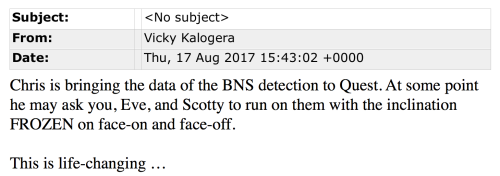
On the first day, we were sending emails that had the inkling already of how important this discovery was.
Why? Because the mass of the objects in the new signal were smaller than anything we had seen in gravitational waves before — all together less than about 3 times the mass of the Sun. Our predisposition from all our years of experience in astronomy said that could mean only one thing: the LIGO-Virgo network had just detected the first binary neutron star merger in history. Today, we call this event GW170817.
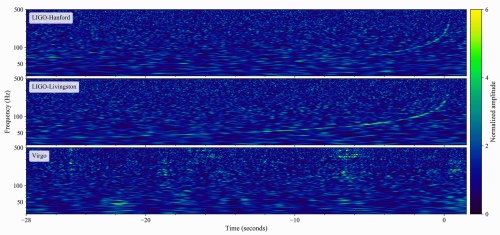
Spectrograms show how the frequency of the signal (vertical axis) changes in time (horizontal axis) in each of the three detectors. The long swoop up and to the right is called a chirp. [Image: LIGO-Virgo]
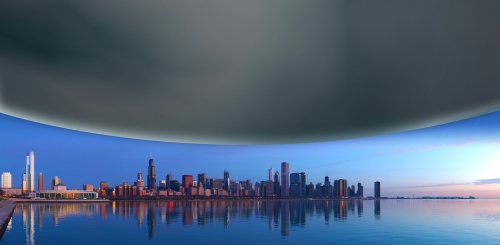
A neutron star (diameter 20 km) scaled to the Chicago skyline. [Image: LIGO-Virgo/Daniel Schwen/Northwestern]
The collision of the neutron stars smashes all the matter together, and under such energetic circumstances, matter generates light. The gamma-ray burst was only the beginning. The collision sheds matter into a volume around the merging pair. This matter, suddenly free of the strong nuclear forces involved in the dense matter of the neutron star, recombines and makes heavy elements (physicists call this “r-process nucleosynthesis“). This recombination also creates light, and is called a kilonova. Following the gamma-ray burst there is also a long term afterglow, from the energetic jet of the gamma-ray burst blasting through the surrounding interstellar medium.

Different phases of emission of electromagnetic radiation from the binary neutron star merger. (L) The initial gamma ray burst. (C) The kilonova from nucleosynthesis. (R) Long term afterglow from energized material around the event. [Images: NASA-GSFC SVS]

The LIGO error ellipses plotted on a skymap of the Hydra-Virgo region. The galaxy NGC 4993 is visible in amateur telescopes. [Image: S. Larson]
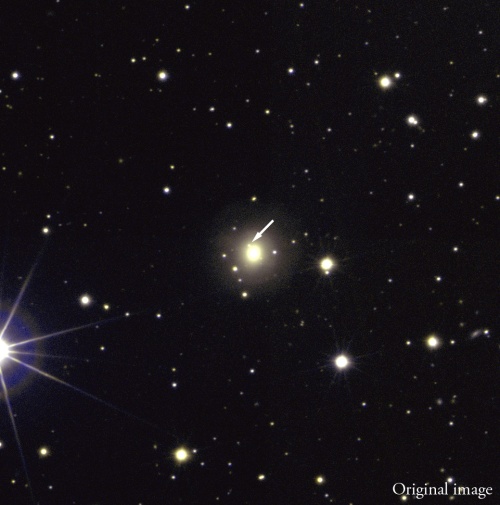
An image of the kilonova associated with GW170817; the fuzzy blog is NGC 4993. [Image: TOROS Collaboration, M. Diaz]
Probably the most important outcome is the confirmation of the connection between short gamma-ray bursts and binary neutron star mergers. Gamma-ray bursts have been a mystery for more than 40 years. First discovered in the 1960s by the military using satellites meant to monitor nuclear weapon tests, the discovery that they were of cosmic origin was revealed to the scientific community in the 1970s. Since then many ideas and models to explain their origin and intense energy have been explored, but none have been confirmed because the engines — the astrophysical systems that drive them — are far too tiny to resolve in telescopes. The LIGO-Virgo detection of gravitational waves confirms that neutron star binaries are the progenitor of short gamma-ray bursts.
The result that I’m most excited about is we used GW170817 to measure the expansion of the Universe. The expansion of the Universe was first noted by Hubble in 1929, by measuring the distances to other galaxies. This was being done just 5 years after the discovery that there were other galaxies! Fast forward 88 years to 2017 — we’ve measured the expansion of the Universe independently using the distance to a galaxy with gravitational waves and light from telescopic observations together. This measurement comes just two years after the discovery of gravitational waves! It gives me no small amount of pleasure to echo that historic discovery so close to the beginning of this new era of astronomy. 🙂

Top shows Hubble’s original 1929 diagram (from PNAS, 168, 73[1929]); bottom shows the location on this diagram of the GW170817 measurements, at the + mark. [Image: W. Farr/LIGO-Virgo]
There are of course many things we still don’t know about the discovery. Foremost among them is this: what is the thing that formed after the merger of the two neutron stars? Some of us in the astrophysics community think it might be some kind of exotic super-neutron-star, larger than any neutron star ever detected. Some of us in the astrophysics community think it might be some kind of exotic light-black-hole, smaller than any black hole ever detected. Whatever it is, it lies within a very fuzzy range of masses that we call the mass gap — a range of masses where we have never seen any stellar remnant. What is the lightest black hole Nature can create in the Universe? What is the heaviest neutron star Nature allows? These are questions we would very much like to know the answer to. At least for the moment, it seems we may not learn the answer from GW170817, but with future detections of binary neutron star mergers we may.
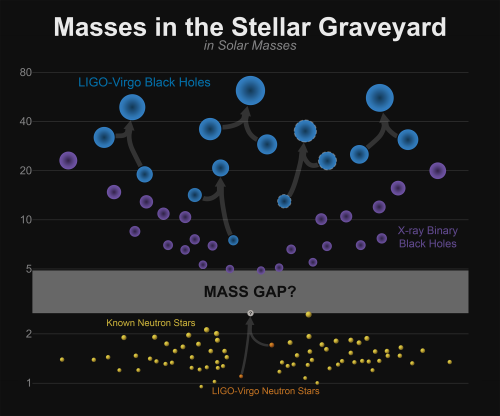
The masses of known stellar remnants discovered by both electromagnetic and gravitational wave observations. Between the black holes and the neutron stars is the “mass gap.” [Image: LIGO-Virgo/Frank Elavsky/Northwestern]
We could all use a nap. And a pizza.
Because this is only the beginning, the culmination of decades of hard work, difficult hardships, and anticipation. And the best is yet to come. I’m so happy that I’ve seen these days. Being tired doesn’t bother me, all the struggles getting to this point don’t bother me either, because I got to watch it unfold. As Death said, we get what anyone gets; we get a lifetime. These are the moments, the discoveries, that are filling that lifetime up. Onward to the next one.
———————-
This post is the latest in a long series that I’ve written about all the LIGO detections up to now. You can read those previous posts here:
The Harmonies of Spacetime – GW150914
My Brain is Melting – GW150914 (part 2)
The Cosmic Classroom on Boxing Day (GW151226)
New Astronomy at the New Year (GW170104)
Focusing our Gravitational Wave Attention (GW170814)
———————-
I have many LIGO and Virgo colleagues who also blog about these kinds of things. You may enjoy some of their posts too!
- Amber Stuver (Villanova): First Observation of a Neutron Star with Gravitational Waves and Light!
- Jocelyn Read (Fullerton): The gravitational-wave story of a neutron-star merger
- Martin Hendry (Glasgow): How we discovered gravitational waves from ‘neutron stars’ – and why it’s such a huge deal
- Mark Hannam (Cardiff): Kaboom! Two kinds of astronomy collide, and produce a burst of science
- Christopher Berry (Birmingham): GW170817—The pot of gold at the end of the rainbow




Great post. This explained it really well.
Awesome achievement, Shane and so very well written! Sent an email to all BSAC club members and suggested they read it.
Thanks, Mark!
Pingback: GW170817: la fusión de dos estrellas de neutrones | Astronomía | La Ciencia de la Mula Francis
Pingback: Allgemeines Live-Blog ab dem 12. Oktober | Skyweek Zwei Punkt Null
Intriguing! The article is featured on my Nature email subscription. Glad that I read it.
Thank you for reading!
I was also pointed here by the Nature daily email. Thank you for taking the time to reach out to us interested lay people. Our tax dollars and euros have been well spent.
I’m glad you enjoyed the post!
An awesome clear paper for us non specialists in the field. Remarkable! Thank you so much for tweeting it.
I”m glad you enjoyed it!
Pingback: Kilonova pertama dikesan menerusi pancaran cahaya Gamma dan Gelombang Kegravitian secara serentak! – FALAKONLINE.NET